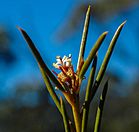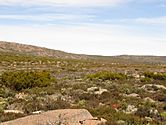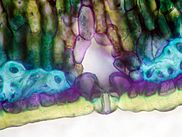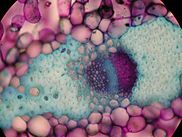Yellow bush facts for kids
Quick facts for kids Yellow bush |
|
|---|---|
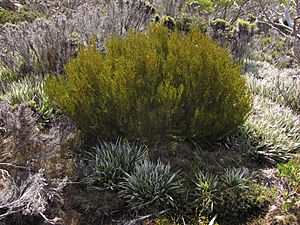 |
|
| Orites acicularis growing in a cold, high-up area on Mount Wellington, Tasmania. | |
| Scientific classification | |
| Genus: |
Orites
|
| Species: |
acicularis
|
| Synonyms | |
|
|
Orites acicularis, also known as the yellow bush, is a special plant found only in Tasmania, Australia. It belongs to a group of plants called Orites, which are part of the Proteaceae family. A Scottish botanist named Robert Brown first described this plant in 1810.
What Does It Look Like?
The yellow bush is a woody, rounded shrub. It usually grows to be about 1 to 1.5 meters (3 to 5 feet) tall. It can spread out to be about 0.5 to 1 meter (1.5 to 3 feet) wide. It has many branches that grow upwards.
Its leaves are a bright yellow-green color. They are smooth (meaning they have no hairs) and tough. Each leaf is about 10 to 35 millimeters long. They have a sharp point at the end, which is often yellower than the rest of the leaf. The top surface of the leaf has a small groove in the middle. The edges of the leaves are smooth. Each leaf connects to the stem with a short stalk called a petiole, which is about 2 to 5 millimeters long.
The plant flowers in December. Its flowers grow on a central stem called a rachis, which can be at the end of a branch or along its side. The flowers have four white-cream petals, called tepals. Each tepal has a groove down the middle and curls under. This shows off the pink part of the flower inside.
The young fruits are green, just like the leaves. They are smooth and oval-shaped. They have a long, reddish-brown tip. When the fruit is fully grown, it becomes hard and stands upright. It is about 15 millimeters long and shaped like a boat. This boat shape helps the seeds to be released right away when they are ready.
Where Does It Live?
Orites acicularis often grows in the high, cold mountain areas of Tasmania. It likes to live in open, shrubby lands called heaths. It also grows in rocky areas with lots of boulders. The rocks in these places are often dolerite, granite, and diorite.
Dolerite rocks break down very slowly. This means the soil in these areas is thin and doesn't have many nutrients. It also has lots of rock pieces. In these high-up plateaus, there are often dips in the rocky ground. Here, plant and rock bits gather, forming wet, spongy areas called bogs. Sometimes, these dips create smaller spots with deeper soil. Also, thick, low-growing plants can stop water from draining away. This creates shallow, wet soils called peats.
Other plants that often grow near Orites acicularis include: Gleichenia alpina, Astelia alpina, Baeckea gunniana, Bauera rubioides, Orites revoluta, Richea sprengelioides, Tasmannia lanceolata, and Eucalyptus coccifera.
How It Handles the Sun
Orites acicularis has developed special features to protect itself from too much sunlight. These features help it avoid getting damaged by strong sun rays. Two of these adaptations are its "abaxial pseudohypodermis" and its "bundle sheath extensions."
Imagine tiny support beams inside the leaf. These are called bundle sheath extensions. They are made of strong cells that stretch from the leaf's veins all the way to its outer skin. In plants that live in sunny, open places, these extensions help protect the leaf from too much sun.
The "Orites-type abaxial pseudohypodermis" is another protective layer. It's made of long, tough cells that form a net-like pattern. This layer is just under the plant's waxy outer coating, called the cuticle. It acts as an extra shield against strong sunlight.
What's in a Name?
The second part of the plant's scientific name, acicularis, comes from Latin. It means "needle-shaped." This describes the plant's pointy leaves.


